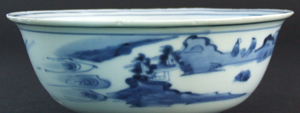
TIANQI 1621 – 1627 Transitional Porcelain
A Ming Dynasty, Tianqi Period 1621-1627, Blue and White Porcelain Bowl Made for the Japanese Market. The Exterior Decorated a River or Coastal Scene Showing a Promontory with a Small Building Near a Large Weeping Willow Tree. There are Numerous Islands One of Which has Two Figures Playing Weiqi.
SOLD
- Condition
- The edge with fritting and small glaze chips.
- Size
- Diameter : 13.5 cm (5 1/2 inches)
- Provenance
- From a Private English Collection of Chinese and Japanese Blue and White Porcelain.
- Stock number
- N/A
Information
Ko-Sometsuke :
Ko-Sometsuke, meaning `Old Blue and White` is a term used to describe Chinese blue and white porcelain made for Japan. This late Ming porcelain was made from the Wanli period (1573-1620) and ended in the Chongzhen period (1628-1644), the main period of production being the 1620`2 and 1630`s. The porcelain objects produced were made especially for the Japanese market, both the shapes and the designs were tailored to Japanese taste, the production process too allowed for Japanese aesthetics to be included in the finished object. Its seams firing faults were added, repaired tears in the leather-hard body were too frequent to not, in some cases, be deliberate. These imperfections as well as the fritting Mushikui (insect-nibbled) rims and kiln grit on the footrims all added to the Japanese aesthetic. The shapes created were often expressly made for the Japanese tea ceremony meal, the Kaiseki, small dishes for serving food at the tea ceremony are the most commonly encountered form. Designs, presumably taken from Japanese drawings sent to China, are very varied, often using large amount of the white porcelain contrasting well with the asymmetry of the design.
Weiqi / Go :
Known in Chinese as Weiqi and Go in Japan it has similarities to chess. The game is played by two players who alternately place black and white stones on the vacant intersections of a grid of 19×19 lines. The object of the game is to control (surround) a larger portion of the board than the opponent, it is rich in strategy despite its simple rules. Weiqi originated in ancient China more than 2,500 years ago, and although it is not known exactly when the game was invented, by the 3rd century BC it was already a popular pastime, as indicated by a reference to the game in the Analects of Confucius. Go reached the West through Japan, which is why it is commonly known by its Japanese name.




